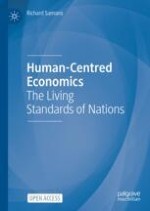Open Access 2024 | Open Access | Buch

Human-Centred Economics
The Living Standards of Nations
verfasst von: Richard Samans
Open Access 2024 | Open Access | Buch

verfasst von: Richard Samans
This open access book examines the chronic underperformance of economies with respect to inclusion, sustainability and resilience. It finds that the standard liberal economic growth and development model has evolved over the past century in a fundamentally unbalanced manner that underemphasizes the crucial role of institutions – legal norms, policy incentives and public administrative capacities – in translating market-based growth in the production of goods and services into broad and sustainable gains in social welfare at the household level. Correcting this imbalance of emphasis in economic theory and policy between markets and institutions, production and distribution, and national income and household living standards is the single most important step required to transcend 20th century trickle-down “neoliberalism” and replace it with a more human-centred model of economic progress in the 21st century.
The book breaks new ground by integrating the principal institutional dimensions of the social contract into the heart of macroeconomic theory and presenting extensive corresponding reforms of domestic and international economic policy to refocus them on the median living standards, rather than primarily aggregate wealth or GDP, of nations. This is the bottom-line measure of national economic performance, and it depends on the strength of both markets of exchange and institutions in such areas as labour and social protection, financial and corporate governance, competition and rents, anti-corruption, infrastructure and basic necessities, environmental protection, education and skilling, etc. Extensive comparative data are presented demonstrating that countries at every level of economic development have ample policy space to narrow their “welfare gaps” – their underperformance on these and other key aspects of household living standards relative to the frontier of leading policy practice in peer countries.